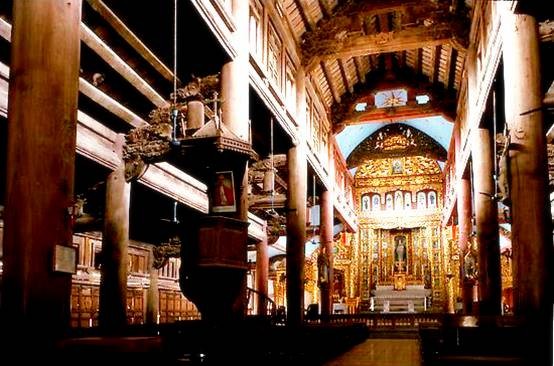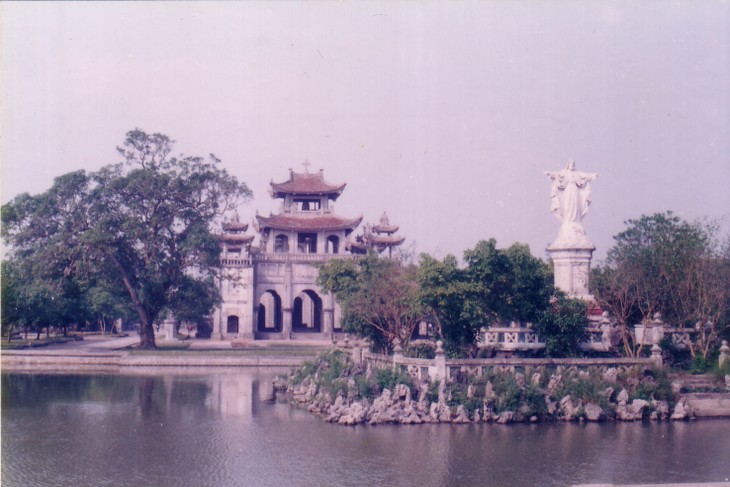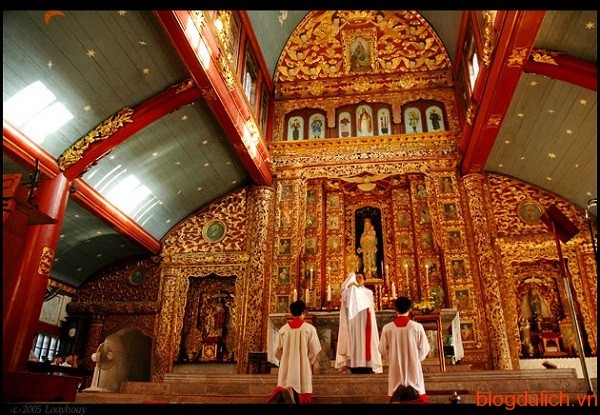(VOVworld) – Covering nearly 22 ha in Kim Son district, Ninh Binh province, Phat Diem Cathedral is a popular destination. Built in the 19th century, it differs from other monuments because of its stone chapel, which is a very successful marriage between eastern and western architecture.
Along the way from Ninh Binh city to Phat Diem Cathedral, there are dozens of churches. But, Phat Diem is the most remarkable because of its unique architecture. It was built at the initiative of Father Pierre Luc Tran, known as Father Six for 34 years from 1865 to 1899. This priest built a large cathedral surrounded by five chapels, plus a campanile, a pond and three manmade stone mountains. The whole constitutes an original set which Western Gothic architecture blends perfectly with that of traditional Vietnamese pagodas.
 |
If we approach the cathedral from the south, we see a pond in the middle of which there is a statue of Jesus opening his arms wide. Just behind it is a stone bell tower whose roof is curved like those on pagodas and communal houses. The stone bell tower is built on 3 levels of large stone slabs and has 3 entries. The first level, the largest, is made of square blue stones. It has 3 rooms with ceiling vaults, each has with stone bed. Do Thi Ngoc Anh is a tour guide:"The high arch symbolizes "round heaven" and the bottom stone bed symbolizes "the square earth", which perfectly matches the design of the Oriental concept of harmony between heaven and earth, between yin and yang. The second level has a large drum and the third has a 1.4m high bell. Cast in 1890, this bell weighs nearly 2 tons. Unlike other church bells that contain a pendulum, Phat Diem’s bell contains a wooden stick that helps the bell be heard 10km away”.
 |
After crossing the campanile, we look up to admire the front of the Great Cathedral, which is the heart of the Phat Diem architectural ensemble. It was built in 1891 with the official name of "Cathedral of Our Lady Queen of the Rosary". Supported by 52 pillars in 6 rows, it includes 9 bays that celebrate the East-West architectural combination. The entrance is exactly like a Gothic church with its raised ceiling, but the columns are carved with typical oriental motifs, including Vietnamese. Do Ngoc Hung is an architecture student:"I am very impressed by the altar of God. The wooden walls are intricately carved and gilded. The altar itself is in stone. The carvings are superb. I heard that the altar is made of 6 stone slabs in the basement housing the tombs of six bishops”
But the most precious jewel of the architectural ensemble of Phat Diem is the Chapel of the Immaculate Heart of Mary, which some call "the stone church." Do Thi Ngoc Anh told us:"This chapel is almost entirely built of stone, blue stone extracted from Mount Nhoi in Thanh Hoa province. Outside, there are two towers, one of which carries a relief showing the pierced heart of Mary which symbolizes the immaculacy”.
The altar of Mary is made of stone. Vietnamese artisans carved various motifs on the stone including phoenix, lotus, pine, chrysanthemums, bamboo, and plum blossoms. At Phat Diem, mass is held in the main cathedral. The surrounding chapels are dedicated to 4 different saints. The chapel of St. Joseph was built in 1899. Its furnishings are made entirely of solid wood. The quintessence of the ancient tradition of Vietnamese wood carving converges here. Do Thi Ngoc Anh again: "South of the main cathedral is the Saint Roch chapel which was built in 1895. The altar is a monolith. To the west is the St. Joseph Chapel, built in 1896 entirely of iron wood. To the north of this chapel is the Saint Pierre Chapel, which was built in 1896. The columns are made of jackfruit wood and are elaborately sculpted”.
 |
Phat Diem Cathedral is a place of prayer and also a popular destination for researchers and tourists. Dustin is from Canada: "It's beautiful. It's unbelievable that this church was built in the 19th century by the Vietnamese. It is typically Vietnamese and completely different from any I have had the opportunity to see. Every detail reflects a perfect symbiosis between stone, wood, East and West".
The vagaries of the weather have not damaged the famous architectural ensemble, but mosses have made it more charming. Behind every relief, every stone lurks something mysterious and sacred waiting to be revealed to visitors.